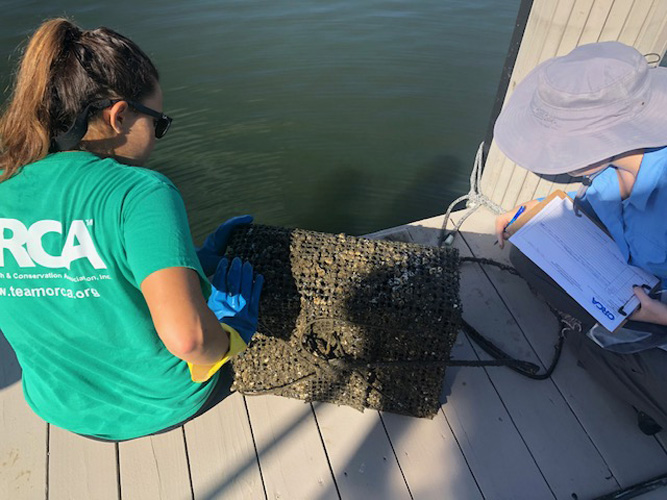
Oysters have been used widely in the Indian River Lagoon for small-scale water purification in recent years, but now the Ocean Research and Conservation Association has begun to use them as sentinels to find and track pollution entering the lagoon.
With the help of residents at the Moorings Yacht & Country Club and students at nearby St. Ed’s, ORCA is deploying oysters in cages at the community’s docks as biological alarm bells.
“Our focus at ORCA is upstream solutions,” ORCA founder and chief scientist Dr. Edie Widder said. “You can’t take the cream out of the coffee. The idea you can put oysters out there and they take it all away – I’m skeptical.” Hence the idea of using the filter-feeding creatures, which can purify up to 30 gallons of water a day each, as sentinels.
The pilot project began last summer when Moorings “Green Team” leaders Judi Honiss and Ardi Schneider invited Widder and her colleagues to place six cages containing 30 oysters each at three of the community’s lagoon docks. St. Ed’s marine science teacher Meghan Buckley’s students helped Moorings volunteers build the cages.
Various oyster restoration projects have been conducted throughout the 156-mile-long estuary for years by researchers and conservationists hoping the mollusks would proliferate and remove toxins and other pollutants that feed algae blooms and kill marine life. But results so far have been mixed, and Widder had become doubtful about their effectiveness.
For that reason, she decided this oyster project would be different: While the oysters would still purify the water around them to some extent, the main purpose of the deployment would be for the oysters to tell the scientists what, exactly, is going on with water quality in the lagoon, providing information to guide future restoration projects.
Here’s what’s happened so far:
After being deployed in August, the oysters and their cages were brought up monthly for observation – the last time in November.
Widder said the results were, to put in mildly, unexpected. The mollusks, she said, grew like “gangbusters” – one third of a millimeter per day.
“It was crazy,” she said. “Growth was phenomenal.”
That was the good news; the bad news, she said, was that tests using bioluminescent bacteria revealed the oysters had become “very toxic, very fast.”
They might be growing quickly but eating them would not be a great idea.
However, while the bioluminescent assays revealed the presence of toxins, the test did not identify them. So Widder sent samples out for more specific tests.
Turns out, the usual suspect – microcystin, a toxin produced by blue-green algae that has killed pets and made people sick – was not the culprit. So that finding called for even more tests to check for the presence of heavy metals and for glyphosate, the active ingredient in the popular herbicide Round Up, which is blamed for causing non-Hodgkin’s lymphoma in some people exposed to it.
Results of those tests are still pending. But the first phase of the pilot project, Widder and Green Team members say, indicates a clear need for a phase two that will provide expanded monitoring and, eventually, help pinpoint the nature and sources of pollution in the lagoon near the Moorings.
So now more Moorings residents are being recruited to sponsor oyster-cage test sites with more cages and more oysters deployed for a longer period than in phase one. And Widder hopes more communities lining the lagoon will get on board.
“We are very gratified that folks at the Moorings are willing to help us,” Widder said. “We’re using the oysters to find where pollutants are entering the system and then follow the source. We can give a report card on the lagoon from the oysters’ point of view.”



